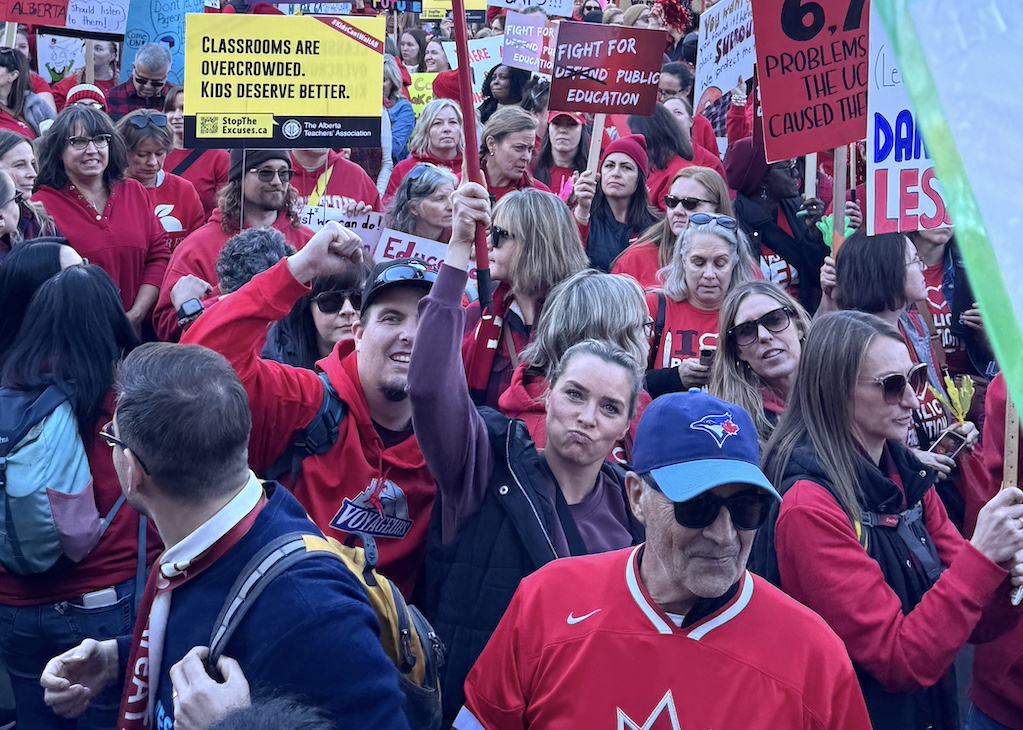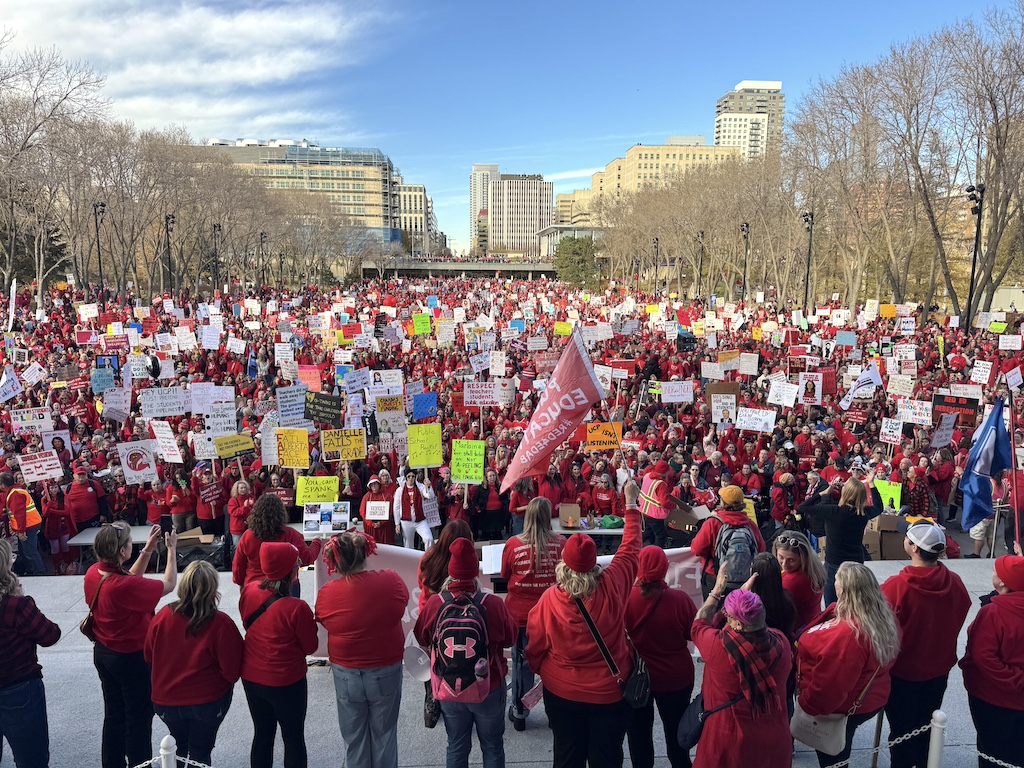Alberta’s Teachers’ Strike Could Spark a Wider Revolt
Over 51,000 teachers are on strike for fair pay and manageable classrooms in Canada’s most right-wing province. With the threat of back-to-work legislation looming, other unions are indicating that they may join the fight.

With classrooms overcrowded and wages eaten away by inflation, 51,000 Alberta teachers have walked out on strike. (Courtesy of Jay Procktor)
Over 51,000 teachers in Alberta, Canada are on their first-ever province-wide strike, demanding meaningful salary increases and better working conditions.
As the strike enters its third week, Premier Danielle Smith’s right-wing United Conservative Party (UCP) government is threatening back-to-work legislation — a move that could spark solidarity actions from other unions across the province.
According to the teachers’ union, stagnating wages are undermining recruitment and retention, and further exacerbating the challenges posed by swelling classrooms and increasingly complex student needs.
While the Alberta Teachers’ Association (ATA) and the Teachers’ Employer Bargaining Association (TEBA) have been negotiating since early 2024, Premier Smith and her UCP government have refused to address teachers’ concerns. By September of this year, bargaining had reached an impasse and the union was gearing up for strike action.
The strike has erupted under the shadow of broader right-wing attacks on public education, including increased subsidies for private and charter schools and an overhaul of the curriculum — all while teachers report surging workloads and shrinking say in how their classrooms are run.
On the day before the strike began, thousands of supporters rallied in cities and towns across the province to show their support for teachers and public education, with 18,000 gathering at the Alberta legislature in Edmonton.
For teachers to emerge victorious, sustained public support will be key.
Stagnant Pay and Complex Classes
Teachers and the UCP government are at loggerheads over two primary issues: wage increases and classroom complexity.
Although Alberta educators earn slightly more than the national average for their profession, teacher salaries have increased by only 5.75 percent over the past decade, according to the Alberta Teachers’ Association. In other words, the rising cost of living has been steadily eroding any advantages teachers in Alberta once enjoyed.
Aggravating the decline in real wages are burgeoning workloads. Growing class sizes and the increasingly complex needs of students are putting sizable pressures on teachers and students alike. Alberta stands apart as one of only two provinces in Canada without collectively bargained student-to-teacher ratios.
The government’s response has been to frame teachers’ demands for higher pay as the reason additional staff can’t be hired and class sizes reduced.
“What teachers want is simple: classrooms that are properly funded and wages that reflect their value to Alberta’s future. For the government to state that teachers would sacrifice their students’ learning conditions for salary is insulting. Teachers should not have to choose one or the other,” ATA president Jason Schilling said in response.
When bargaining failed to move the employer and government on these issues, the parties agreed to enter an ultimately unsuccessful round of mediation.
Rejecting the mediator’s recommended settlement, including a general wage increase of 12 percent over four years, the teachers voted 95 percent in favor of strike action in June. This affirmed that union members were prepared to walk off the job to achieve their goals of meaningful raises and manageable class sizes.

“Alberta teachers are sending an unmistakable message. We are united, we are determined, and we will no longer hold up a crumbling public education system that this government fails to fund properly,” ATA president Schilling said at the time.
The union then issued its strike notice on September 10, giving parents, students, and the government substantial warning that job action would commence on October 6.
However, in a surprise move, the union reached a tentative settlement with the Teachers’ Employer Bargaining Association and put the offer to members for a vote in late September. The response from teachers was unequivocal. Members rebuffed that “memorandum of settlement” by nearly 90 percent, paving the way for province-wide strike action.
The Most Stressed Teachers in the West
Throughout negotiations, the union has expressed frustration at the employer-side bargaining team’s apparent inability to address core issues. According to the ATA, school board representatives indicated during bargaining that they lacked the “mandate” to negotiate over classroom complexity.
The government then accused the union of “bad faith bargaining” at the Alberta Labour Relations Board for communicating this information to its members. Though the complaint was ultimately resolved without the board issuing a decision on the merits of the government’s accusation, the underlying issues of classroom size and complexity remained.
In fact, the Teaching and Learning International Survey (TALIS) — a worldwide study of teachers’ working conditions conducted by the Organisation for Economic Co-operation and Development (OECD) — confirms the union’s position. In 2024, the TALIS found that teachers in Alberta faced the highest levels of occupational stress among the fifty countries participating in the survey.
Forty-two percent of Alberta teachers reported experiencing high stress levels, compared to 19 percent of teachers globally. Strikingly, only 13 percent felt respected by their government.
Ignoring this evidence, the UCP government has refused to bargain a settlement that wouldn’t put kids back into overcrowded classrooms staffed by undercompensated teachers.
The “Nuclear Option”
Failing to respond to the legitimate grievances of teachers, the Alberta government has instead offered parents payments of $30 per day for each child impacted by the strike. A miserly sum for parents and guardians scrambling to provide care for out-of-school kids, the political gimmick is costing the province as much as $15 million a day.
In yet another insulting offer, the government proposed entering intensive mediation with binding recommendations — but only if the union would agree to end its strike on October 20. Even then, the mediator would be barred from touching on the very issues at the heart of the dispute: classroom sizes and student-teacher ratios.
Predictably, the union rejected this invitation to nowhere.
Unwilling to spend the resources necessary to pay teachers fairly and reduce class sizes, Premier Smith has been signaling that government intervention to crush the strike is soon coming.
Rather than negotiate a way out of this prolonged dispute, the UCP prefers the bludgeon of back-to-work legislation. The opposition New Democratic Party will oppose this draconian overreach, but with a solid majority, the UCP can easily pass any strikebreaking order they ultimately choose to table.
This wouldn’t be the first time that an Alberta government has forced a contract on unionized teachers. In 2002, contract settlements were imposed on teachers through a combination of binding arbitration at the local school board level and province-wide legislation.
Preventing such an outcome in this case will require a mass public mobilization and, potentially, workers willing to defy a back-to-work order.
Recent polling by Angus Reid suggests that nearly 60 percent of Albertans are supportive of the teachers. Tellingly, 84 percent of respondents believe that there are too many kids in classrooms. Among Albertans, then, there is potential to build the support required to resist.
Moreover, in the midst of the strike, municipal and school board elections were held on October 20 across Alberta’s sixty-one school board districts. With the future of public education at risk, the union has been encouraging voters to show their support at the ballot box as well as on the picket line.
As ATA president Schilling put it in a message to members last month: “The stand we take is not just about salaries or class size; it is about the very soul of public education.”
How this strike ends is yet to be determined. One thing, however, remains certain: it will be up to workers and their supporters to defend public education. That defense may soon take on a broader dimension. With the government’s threat of back-to-work legislation looming, other unions are warning that an attack on teachers will be treated as an attack on the entire public sector.
What began as a strike over fair pay and smaller classes may yet become a test of Alberta’s labor movement itself.